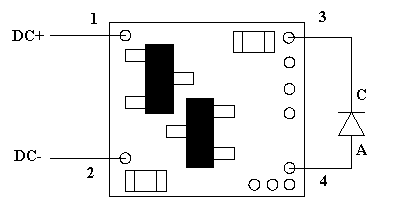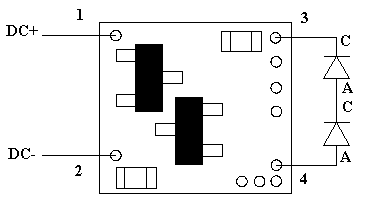Best viewed using:
Internet Explorer
or
Mozilla Firefox
Connecting the N8032 or N8032A Beacon Simulator
Installing the N8032 is very straightforward. Its tiny size and thin construction will allow it to be placed nearly anywhere in any scale model. Because the module has circuitry on both sides, care must be taken to be sure that the components or wires soldered will not make contact with any metal object causing a short circuit.
The N8032 can be powered by battery or any well-filtered and regulated DC power source with an output of 6-18VDC.
Included with the module are two 6” lengths of #32 insulated wire. If necessary, these can be used for power input wires.
Solder point #1 is the + DC power connection as shown in Fig. 1.
![]()
Figure 1
Important note: A low-wattage iron with a pointed tip should be used for connection of wires. Too much heat or solder can easily damage the wires or module and void the warranty.
Also, all connecting wires should be pre-tinned before soldering them to the module. This will make connection quick and easy and ensure excessive heat is not applied to the solder points.
Solder point #2 is the -DC (or ground) power connection.
Connecting LEDs
When connecting the LED, proper polarity must be observed. LEDs are “polarity sensitive” and will not function is connected backwards. The N8032 is configured to connect to a 20 ma LED with a device voltage of 1.85-2.0 VDC. This covers all of Ngineering’s Micro and Nano yellow and red LEDs, as well as many of the yellow and red LEDs available. The N8032A version is configured to connect to a 20 ma LED with a device voltage of 3.2-3.6 VDC. This covers all of Ngineering’s 2x3 white and incandescent LEDs; white, yellow-white and blue Micro LEDs; and white and blue Nano LEDs, as well as many white and blue LEDs available. See Fig 2 below for connection details.

Figure 2
Using wire appropriate for the size of the LED and its placement in the model, connect the LED cathode (the – connection) to point #3 on the module and connect the LED anode (the +) to solder point #4.
An added feature of the N8032A simulator is that it will support a series-wired pair of LEDs with device voltages of 1.85-2.0 VDC (red or yellow LEDs). By doing this, this module will run 2 LED beacons (flashing simultaneously). See Fig 3 below for wiring details.

Figure 3
This completes connection of the N8032/N8032A modules. It is recommended that a thorough re-inspection of all connections and module placement be performed prior to applying power to your model. We hope you enjoy the added realism our module provides.
© 2008 Ngineering





















